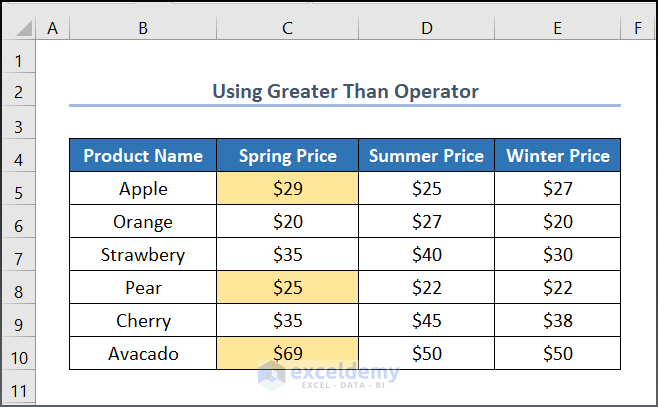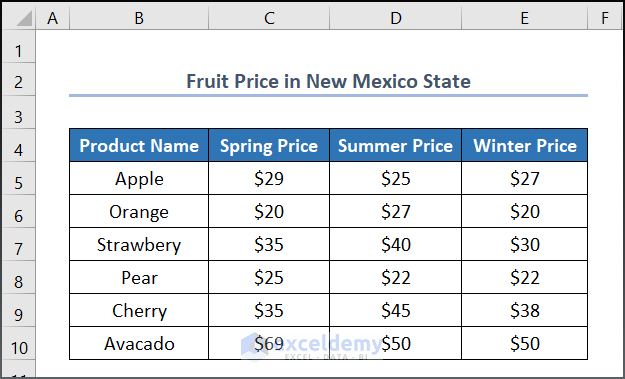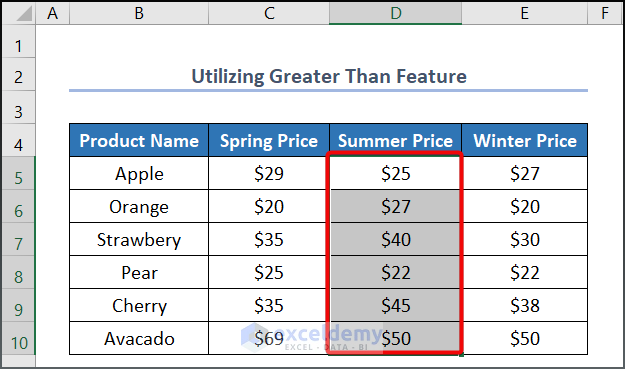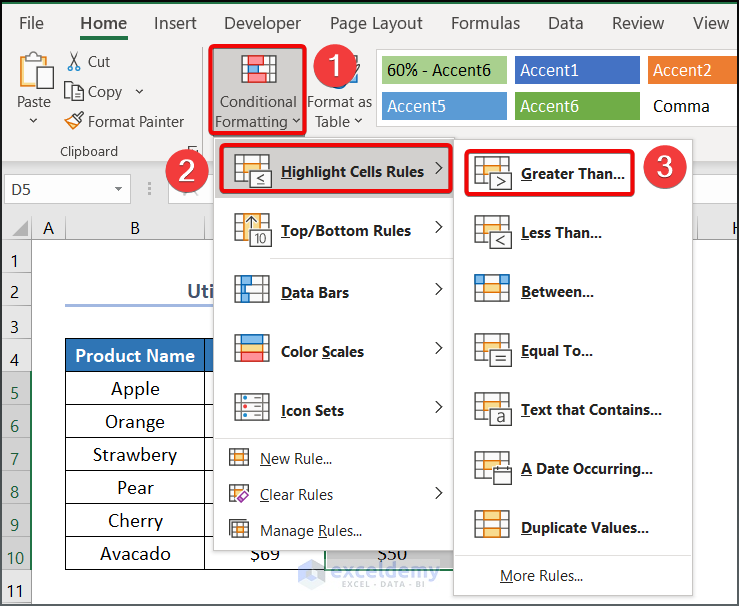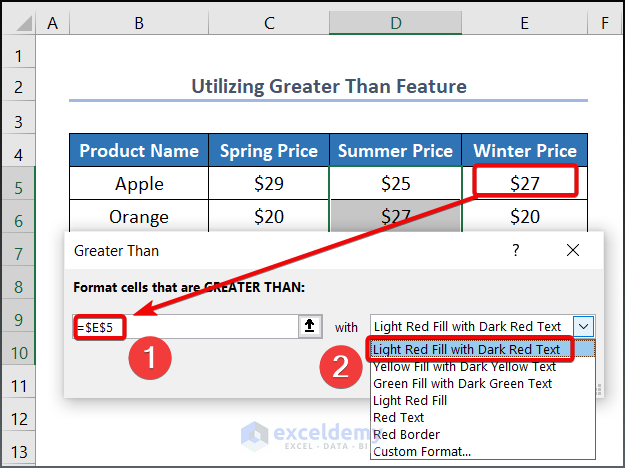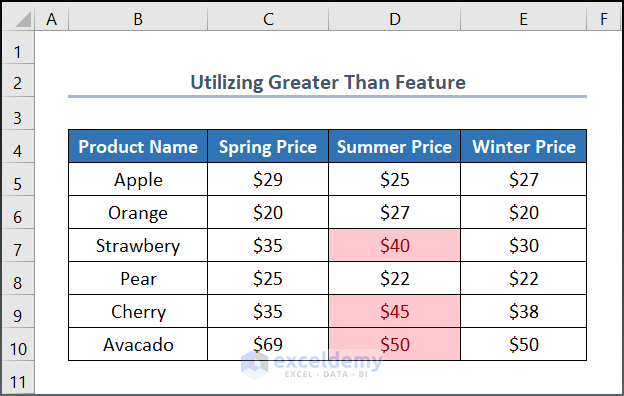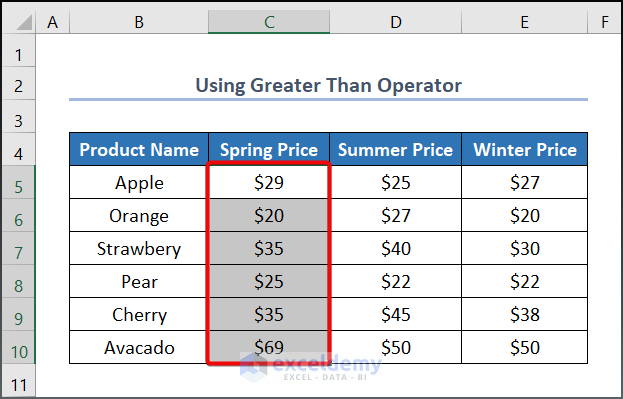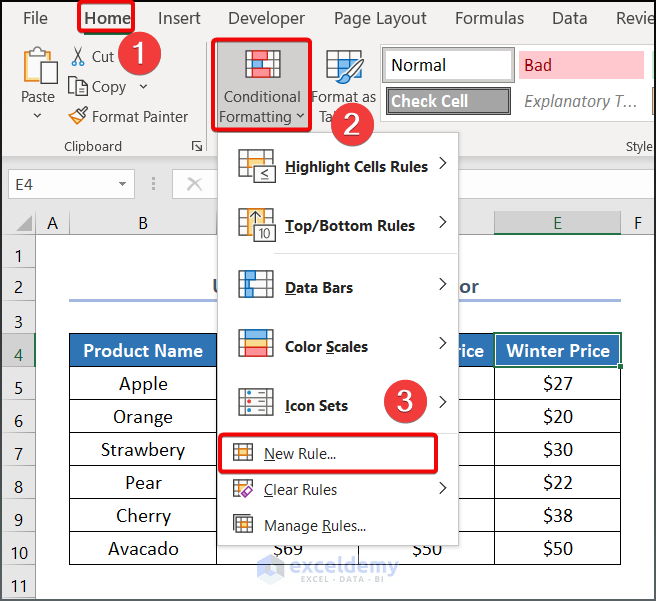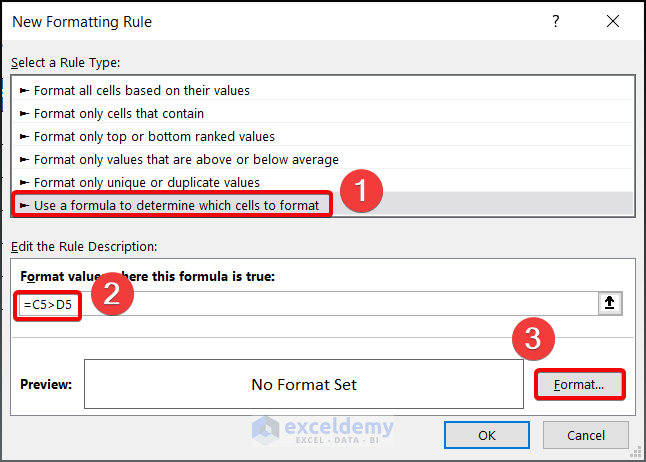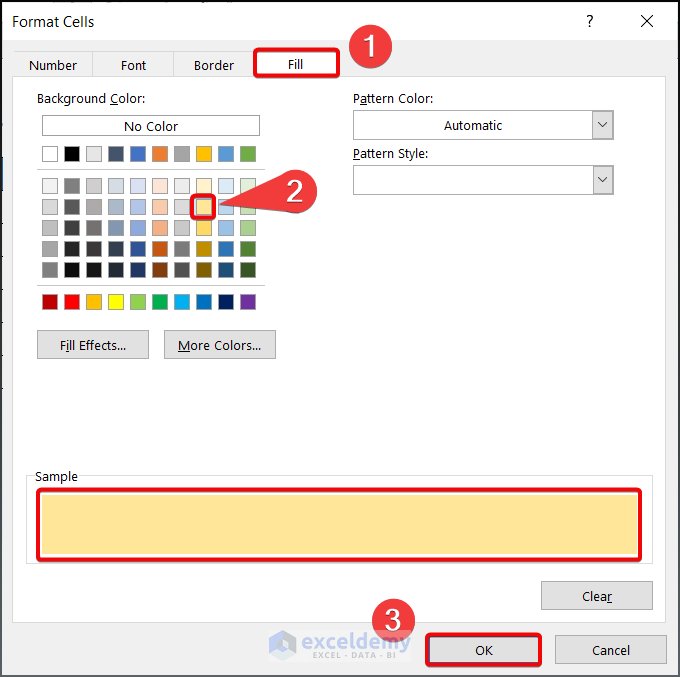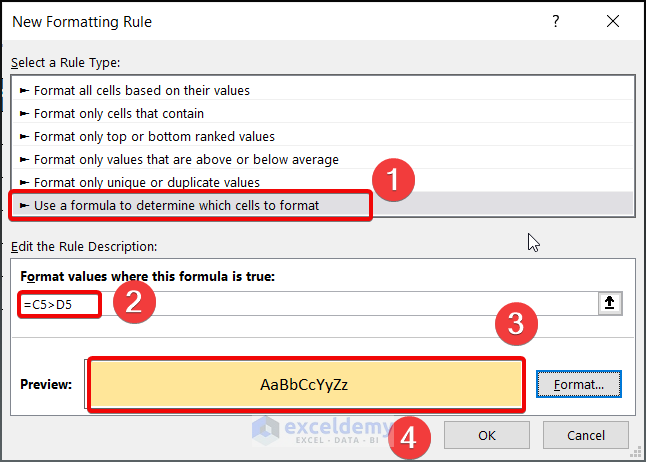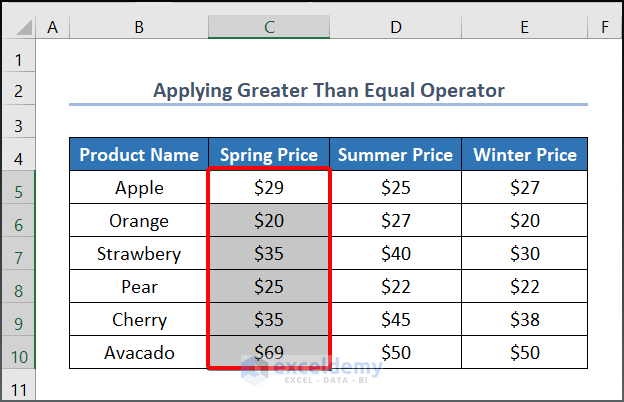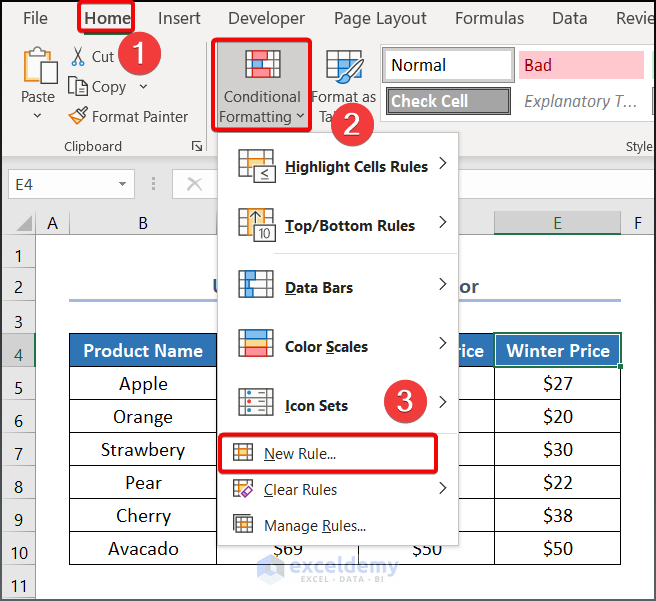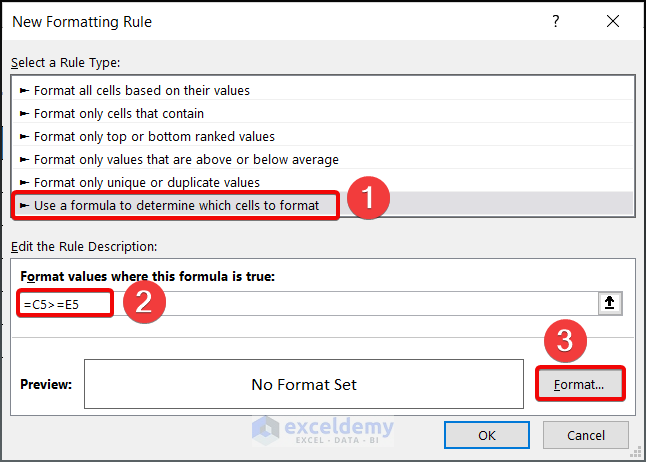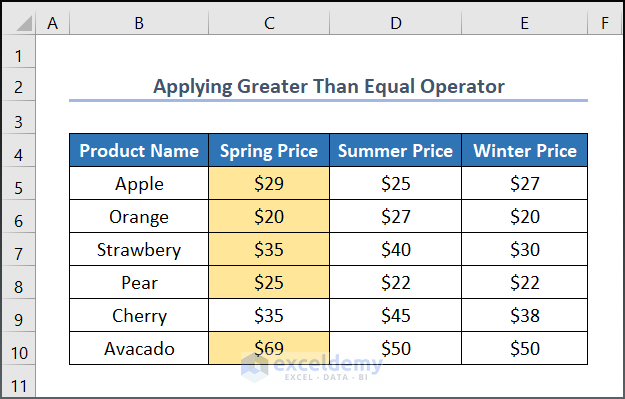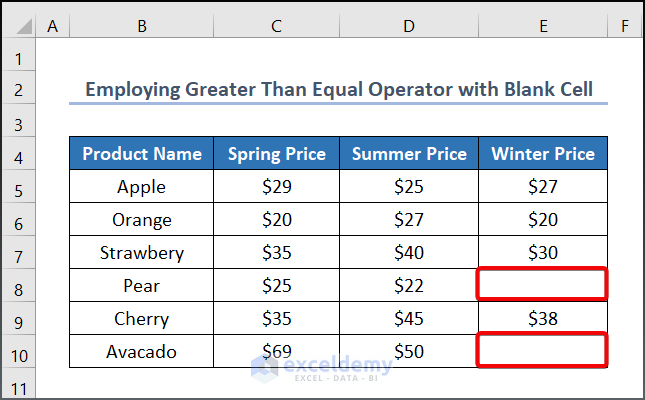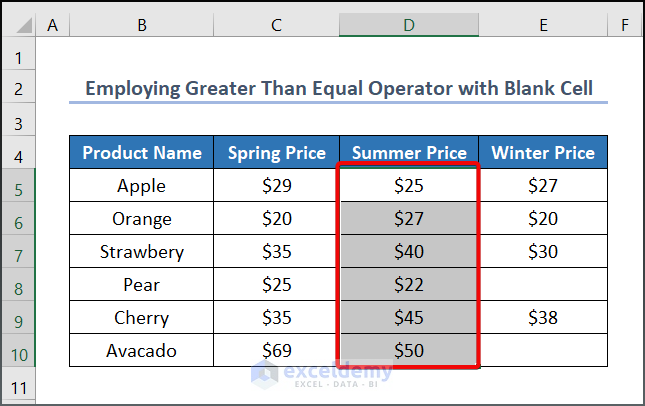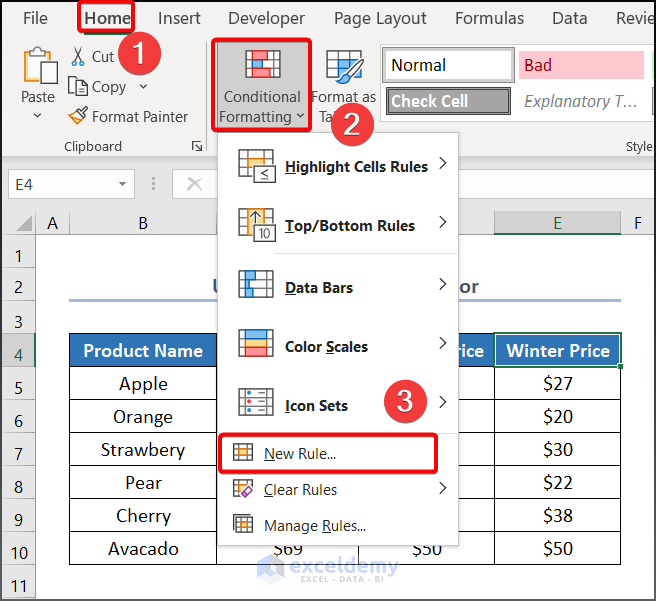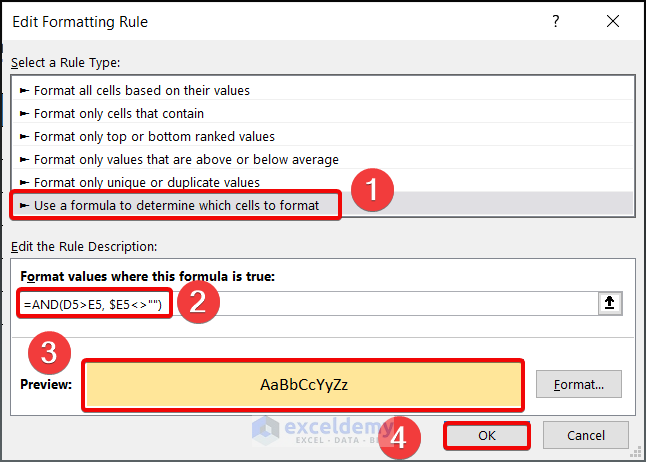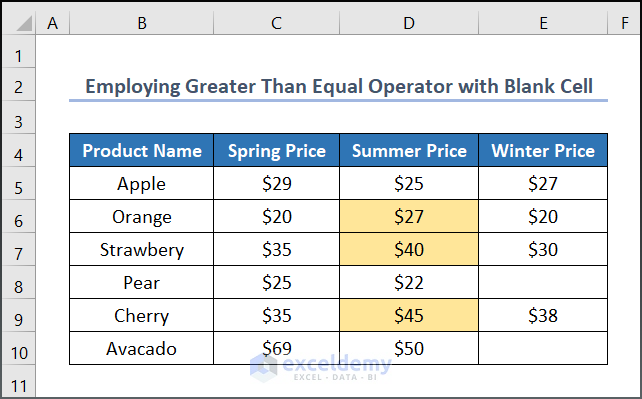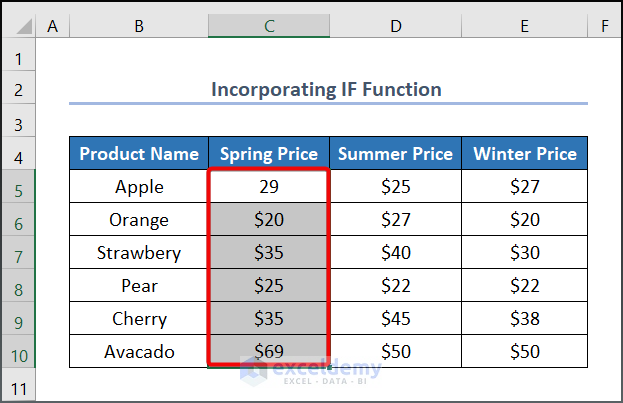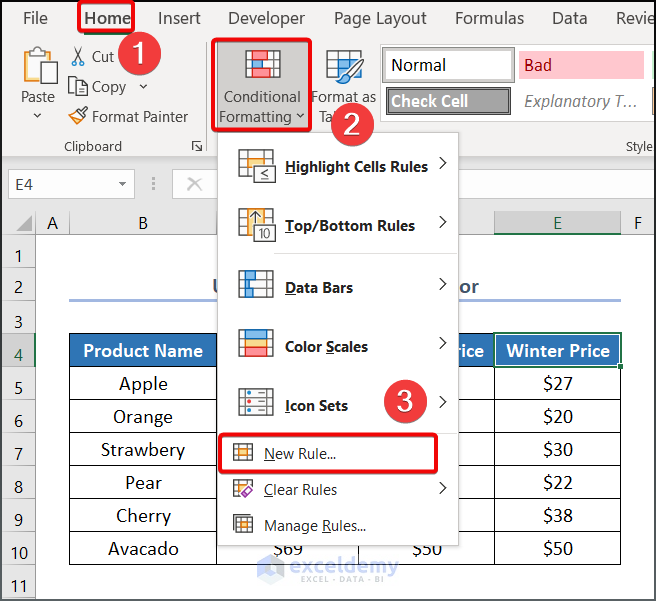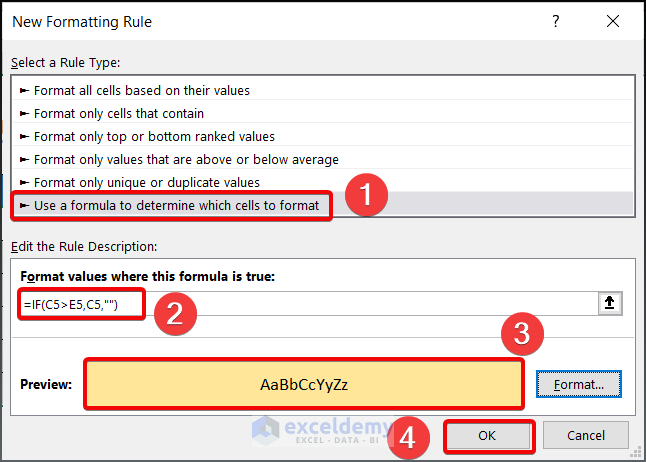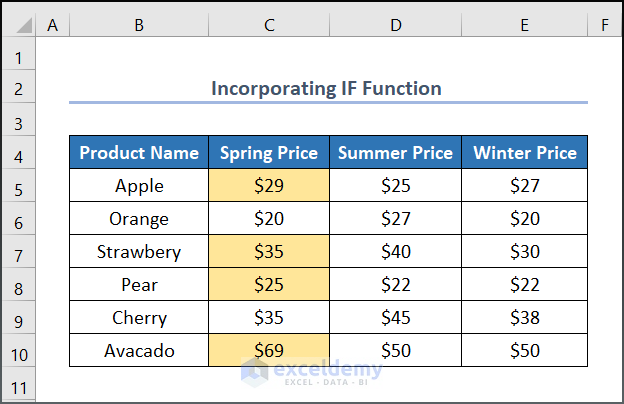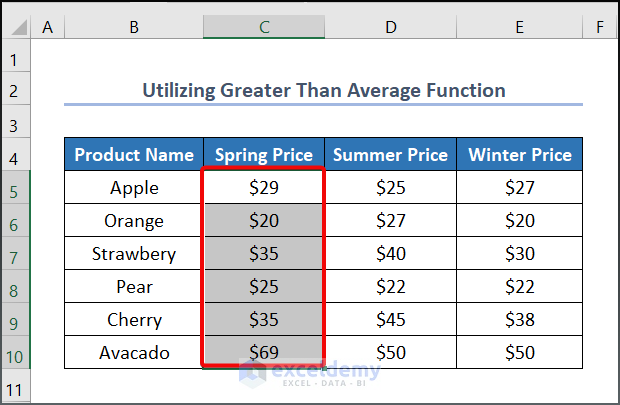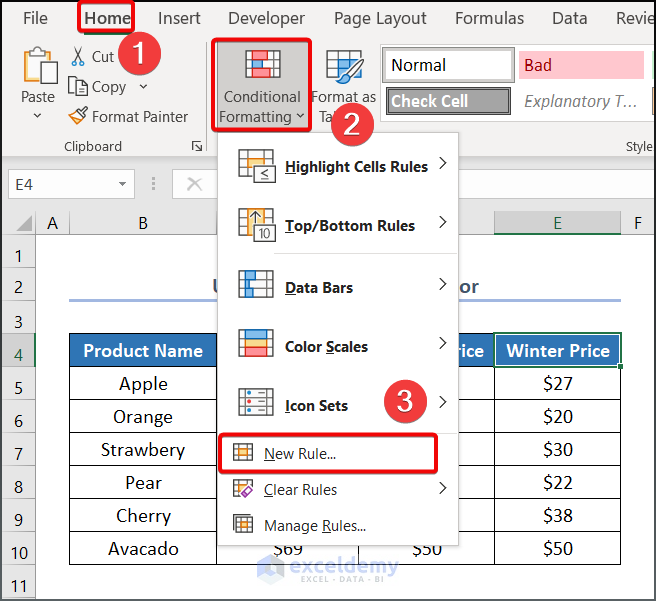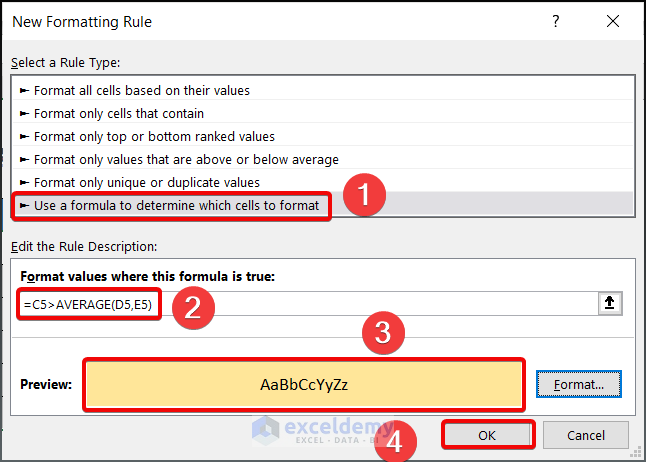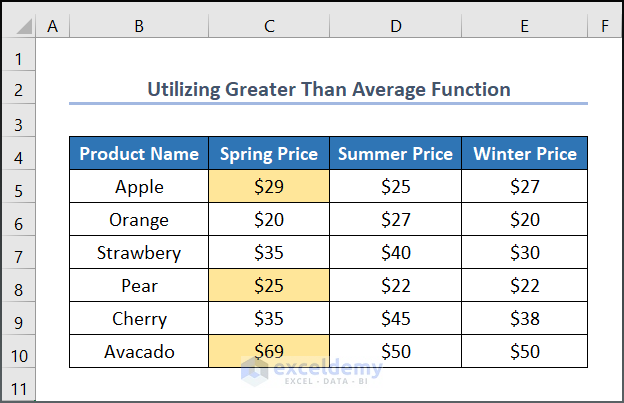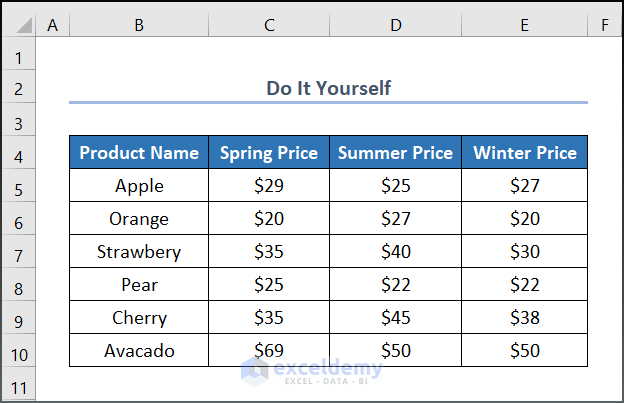To compare any particular product price, availability, etc. in different times or seasons the greater than operator helps us. In this article, I’m going to explain how to highlight cell if value greater than another cell in Excel.
The image depicted below is an overview image and represents highlight cell when the cell value is greater than another cell in Excel.
Highlight Cell If Value Greater Than Another Cell in Excel: 6 Ways
Let’s assume a dataset, namely “Fruit Price in New Mexico State”. This dataset contains 4 columns that represent fruit prices in different seasons. These are Product Name, Spring Price, Summer Price, and Winter Price. Here, I will show you in which season the price is greater than from other seasons. However, you can use any dataset suitable for you.
Here, we have used the Microsoft Excel 365 version; you may use any other version according to your convenience.
1. Utilizing Greater Than Feature to Highlight Cell If Value Greater Than Another Cell
The simplest way to Highlight a cell if the value is greater than another cell is by using the Greater Than command ribbon.
📌 Steps:
- First, select the cell or cell range to Highlight a value Greater Than another cell. Here, I selected the cell range D5:D10.
- Then, Go to the Home tab >> Conditional Formatting >> Highlight Cells Rules >> select Greater Than.
A dialog box will pop up.
- In Format cells that are GREATER THAN, select the other cell with which you want to compare. Let’s select the E5 cell.
- Then select any format to colour where values are Greater Than. Here, I selected Light Red Fill with Dark Red Text.
- Finally, click OK. Thus, you will see all the values Greater Than from the selected cell will be highlighted with the selected format.
Read more: Conditional Formatting Based On Another Cell in Excel
2. Using Greater Than (>) Operator to Highlight Cell If Value Greater Than Another Cell
You can use the Greater Than (>) operator to Highlight the cell if the value is greater than another cell. To demonstrate the procedure, I’ll use the Spring Price and Summer Price columns.
📌 Steps:
- To begin with, select the cell or cell range to Highlight a value Greater Than another cell. Here, i selected the cell range C5:C10.
- Now, open the Home tab >> Conditional Formatting >> select New Rule.
Subsequently, a dialog box will pop up.
- From Select a Rule Type, select Use a formula to determine which cells to format.
- In Format values where this formula is true type the following formula.
=C5>D5Again, a dialog box will pop up.
- Select any color to Highlight your cell. I selected the Gold Accent 4, Lighter 60% color to fill. Press OK afterwards.
- Then, click OK.
- Therefore, It will Highlight the cell values of the Spring Price column where it is Greater Than the Summer Price column.
Read more: Excel Conditional Formatting Based on Multiple Values of Another Cell
3. Applying Greater Than Equal (>=) Operator to Highlight Cell If Value Greater Than Another Cell
You also can use the Greater Than (>=) operator to Highlight the cell if the value is greater than equal to another cell. To demonstrate the procedure, I’ll use the Spring Price and Winter Price columns.
📌 Steps:
- To begin with, select the cell or cell range to Highlight a value Greater Than Equal to another cell. I selected the cell range C5:C10.
- Now, open the Home tab >> from Conditional Formatting >> select New Rule
Subsequently, a dialog box will pop up.
- From Select a Rule Type, select Use a formula to determine which cells to format.
- In Format values where this formula is true type the following formula.
=C5>=E5- From Format, select the format of your choice to Highlight the cell where the value is Greater Than Equal.
- In the end, click OK. Therefore, It will Highlight the cell values of the Spring Price column where it is Greater Than Equal to the Winter Price column.
4. Employing Greater Than Equal (>=) with Blank Cell to Highlight Cell If Value Greater Than Another Cell
You can use the Greater Than (>) operator with the AND function to Highlight a cell value greater than another cell while skipping Blank Cell. Here, in my existing dataset, I’ve taken some Blank Cells in the Winter Price column.
📌 Steps:
- First, select the cell or cell range to Highlight a value Greater Than another cell except for Blank Cell. I selected the cell range D5:D10
- Now, open the Home tab >> from Conditional Formatting >> select New Rule
Subsequently, a dialog box will pop up.
- From Select a Rule Type, select Use a formula to determine which cells to format.
- In Format values where this formula is true type the following formula.
=AND(D5>E5, $E5<>"")
- From Format, select the format of your choice to Highlight the cell.
- Finally, click OK. Hence, It will Highlight the cell values of the Summer Price column where it is Greater Than the Winter Price column, but you will see that the values that would be compared to the Blank Cells values are not Highlighted as we skipped the Blank Cells using $E4<>”” within the formula.
Read more: Conditional Formatting for Blank Cells in Excel
5. Incorporating IF Function to Highlight Cell If Value Greater Than Another Cell
You can use the IF function to highlight cell if the value is greater than another cell. To demonstrate the procedure, I’ll use the Spring Price and Winter Price columns.
📌 Steps:
- To begin with, select the cell or cell range to Highlight a value Greater Than another cell. I selected the cell range C5:C10
- Now, open the Home tab >> from Conditional Formatting >> select New Rule.
Subsequently, a dialog box will pop up.
- From Select a Rule Type, select Use a formula to determine which cells to format.
- In Format values where this formula is true type the following formula.
=IF(C5>E5,C5,"")
- In the end, click OK. Therefore, It will Highlight the cell values of the Spring Price column where it is Greater Than the Winter Price column.
Read more: Excel Conditional Formatting Formula with IF
6. Utilizing Average Function to Highlight Cell If Value Greater Than Another Cell
You can compare the average of the values while Highlighting a cell. To ease the task you can use the Average function.
To demonstrate the procedure, I’ll calculate the Average of the Summer Price, and the Winter Price column and will check whether the Spring Price column is Greater Than the calculated Average or not.
📌 Steps:
- To begin with, select the cell or cell range to Highlight a value Greater Than another cell. I selected the cell range C5:C10.
- Now, open the Home tab >> from Conditional Formatting >> select New Rule
Subsequently, a dialog box will pop up.
- From Select a Rule Type, select Use a formula to determine which cells to format.
- In Format values where this formula is true type the following formula.
=C4>AVERAGE(D4,E4)
- From Format, select the format of your choice to Highlight the cell.
- Finally, click OK. As a result, It will Highlight the cell values of the Spring Price column where it is Greater Than the Average of the Spring Price and Winter Price columns.
Practice Section
I’ve provided a practice sheet to practice the explained methods.
Download to Practice
Conclusion
In this article, I’ve explained 6 easy and quick ways of Excel to highlight the cell if value is greater than another cell in Excel. These different ways will help you to highlight a cell compared with another cell if the value is greater than. Last but not least if you have any kind of suggestions, ideas, and feedback please feel free to comment down below.
Further Readings
- How to Format Cell Based on Formula in Excel
- How to Use Conditional Formatting Based on VLOOKUP in Excel
- How to Apply Conditional Formatting with INDEX-MATCH in Excel
- Excel Conditional Formatting Formula If Cell Contains Text
- Applying Conditional Formatting for Multiple Conditions in Excel
- Conditional Formatting If Cell is Not Blank
- How to Change Text Color Based on Value with Excel Formula
- Conditional Formatting Multiple Text Values in Excel
- Conditional Formatting Entire Column Based on Another Column in Excel
<< Go Back to Conditional Formatting with Multiple Conditions | Conditional Formatting | Learn Excel
Get FREE Advanced Excel Exercises with Solutions!